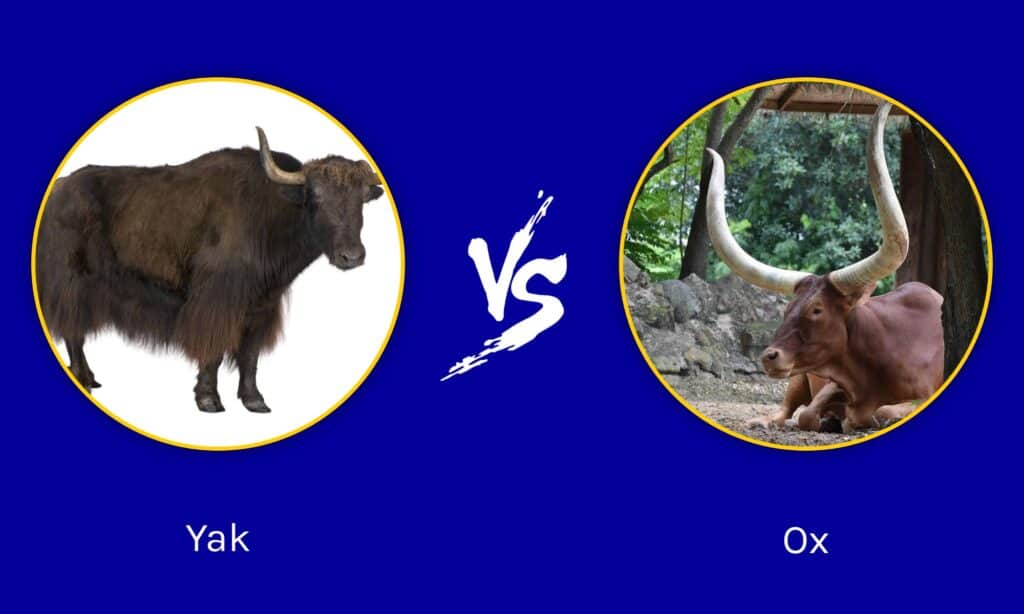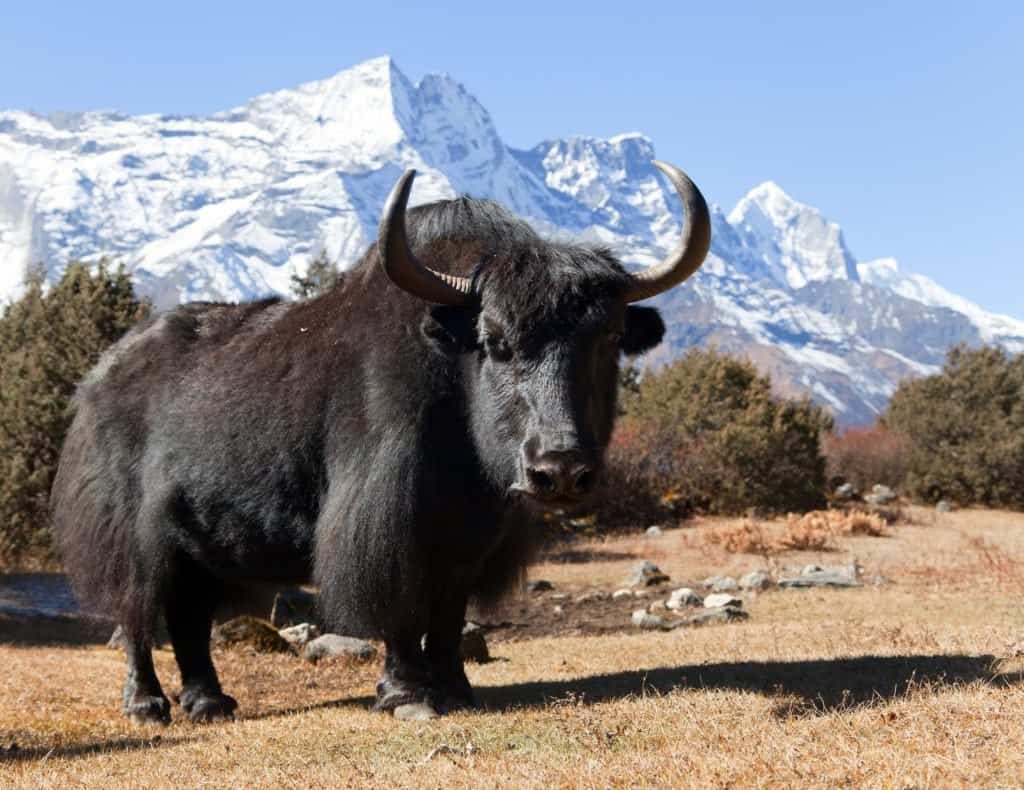The domestication of animals is truly one of the defining factors in humanity’s success all around the globe. Of all of the domesticated animals, few were as instrumental as beasts of burden. Aside from horses, yaks and oxen are two of the most famous domesticated animals, but what exactly are they? Today, we will be taking a look at these animals to learn a little about them and discover what makes them different. Yak vs Ox; a complete comparison.
Comparing a Yak and an Ox

| Yak | Ox | |
|---|---|---|
| Hair | Extremely dense, long fur | Short, occasionally thicker around the neck |
| Castration | Non-breeding yaks are castrated | Generally castrated to make docile |
| Distribution | Originally domesticated in the Himilayas. Currently used in Nepal, Tibet, China, and Mongolia. | Worldwide |
| Uses after domestication | Milk, fiber, meat, beast of burden. | Draft animals |
| Taxonomy | Belong to the Bovidae family, part of the Bos genus. | Belong to the Bovidae family, part of the Bos genus. Considered domesticated cattle. |
The 5 main differences between a yak and an ox
The main difference between a yak and an ox is that the yak is a domesticated bovine from the Himalayas, while “oxen” are castrated male cattle bred for use as draft animals. Additionally, yaks are covered in dense, thick fur and are cold-adapted, while most oxen have short fur. Yaks are used for milk, fiber, meat, and as beasts of burden, while oxen are generally used exclusively for draft work.
Although yaks and oxen are closely related, they have some distinct differences. The modern yak and cow descended from the ancient auroch (the wild yak split 5 million years ago, and the modern cow was domesticated 10,500 years ago). As they are so closely related, they have many similarities, but their varied environments have allowed them to evolve in quite different ways.
Wild yaks were domesticated in the harsh environments in and around the Himilayas and are still used today. Oxen are usually male cattle that have been specially bred and trained for use as draft animals. Draft animals are used to pull carts, till fields and carry heavy loads across distances.
Let’s explore some of the differences between yaks and oxen below!
Yak vs Ox: Hair

Yaks are known for their long fur designed to keep them warm.
©Daniel Prudek/Shutterstock.com
Since yaks have evolved in the frigid and harsh environments of the Himilayas, their appearance reflects it. One of the defining features of yaks is their thick, dense hair that protects them from the cold. They can survive in temperatures as low as -40 Fahrenheit at elevations as high as 6,100 meters in the alpine tundra. Their long hair forms a skirt around them that keeps them warm and safe in these extreme environments.
Oxen are specialized cows, although they have a lot of variation. Most cattle breeds have short hair and aren’t adapted to live in the same environments that yaks are. Oxen don’t have much hair across their body, although they occasionally have extra hair around their necks.
Yak vs Ox: Castration

Oxen are usually castrated to help with their temperament, while yaks are not.
©iStock.com/tadija
Oxen, however, are usually characterized by their castration. Male cows (bulls) can become extremely aggressive and difficult to work with. The best solution is generally to castrate the bulls at a certain age. As this limits testosterone, the oxen are much easier to work with and can be trained for work on farms or as transportation devices. This process has been happening for quite a long time and increases the safety of humans working with the animal. Intact bulls are generally used for breeding.
Yaks can be either wild or domesticated. Domesticated yaks still maintain the ability to breed and have been bred for thousands of years. These animals are occasionally bred with domestic cattle, and the resulting crossbreed is usually sterile. Generally, yaks are kept uncut and bred by their humans.
Yak vs Ox: Distribution

Yaks can be found all over the Himilayas and into Siberia.
©Igor Lushchay/Shutterstock.com
Yaks exist in two categories: wild and domesticated. There are domesticated yaks worldwide as they are sources of novelty, new meat sources, and yak-wool production. The United States, Canada, New Zealand, and some parts of Europe have small yak herds kept by farmers. Still, the bulk of domesticated yaks are found in their native range of the Himalayas. People keep domesticated yaks across the Tibetan Plateau, Northern Myanmar, Yunnan, Sichuan, Mongolia, and Siberia. Wild yaks still exist, although there are only 15,000 likely still around. The Changtang National Nature Reserve in Tibet is home to about half of the wild yak population.
Oxen are used all over the world, especially in rural and agricultural settings. Anywhere domestic cattle exist, oxen are likely to be found. Additionally, oxen are still used in many settings around the world where mechanical farming methods aren’t as available.
Yak vs Ox: Uses after domestication

Yaks can be used as a pack animals, and their body can provide meat.
©Vladimir Mulder/Shutterstock.com
Yaks are heavily utilized by native people all over the Himilayas. Even to this day, they are used in the same ways as they were when they were first domesticated. Yaks are used for milk, fiber, meat, and as beasts of burden. Even more, yak dung is used as a fuel source since the Tibetan Plateau doesn’t have any trees to burn for fires. A traditional cheese known as chhurpi is made using yaks milk, plus yak butter is a common ingredient in Tibetan cooking and in butter tea. As beasts of burden, yaks are used to carry goods between mountain regions.
Yak vs Ox: Taxonomy
Yaks are closely related to today’s cattle and even share a lot of characteristics with them. The relation is so close that both animals are classified in the same genus. Current data shows that modern yaks split from the ancient aurochs about 5 million years ago and became their own species.
Modern cattle are actually a direct descendent of the auroch when humans started domesticating them around 10,500 years ago.
Thank you for reading! Have some feedback for us? Contact the AZ Animals editorial team.








